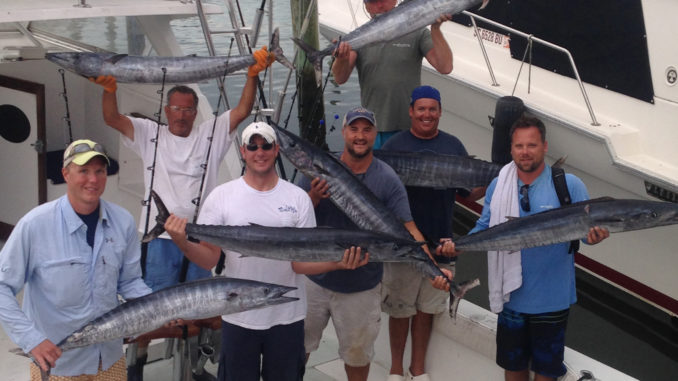
Upwelling of cooler water for ocean floor is holding plenty of baitfish, predators
For most of the summer, Gulf Stream waters have produced their normal mixed results, a scanty bag of the typical favorite targets: wahoo, tuna, king mackerel and amberjack. But the tides are turning for some charter captains, with double-digit wahoo catches on a single trip, and Capt. Shawn Thomas of Murrells Inlet’s Underdog Sport Fishing Charters in the middle of the action.
“Wahoo are very active right now,” said Thomas (843-655-5890). “Just a few days ago, we got 20 hookups and boated 10 off one set of numbers I chose based on my research the night before.”
Typically, sea-surface temperature charters are the golden key for finding wahoo, but during the summer, water temperatures warm nearshore and mix with the warm Gulf Stream current, creating a featureless temperature regime from the beach out to 75 miles offshore. So it was chlorophyll maps produced from NASA satellite coverage that broke things open.
“We finally got some good chlorophyll shots and some clear water over structure that would have the bait, wahoo, and tuna stacked,” he said, explaining that areas rich in phytoplankton activity has a different reflective temperature that overhead satellites pick up. Along the inside edge of the continental shelf, a rise in plankton is a sure sign of an upwelling of cooler water from the ocean floor. The upwelling brings a flood of nutrients to the surface that will spark a chain reaction and a feeding frenzy.
“Most of the wahoo we are catching are in the 30- to 40-pound class, (and) that tells me we are seeing the beginning of the wahoo migration. The bite should remain good over upcoming weeks,” he said.
Thomas’s best action on wahoo is coming from near the surface, where in the nutrient-rich water flows. And he looks for bluebird, sunny days to catch more wahoo over tuna. Tuna will drop into deeper water on bluebird days and leave the shallow region of the water column wide open for the razor-toothed wahoo.
“Tuna tend to be spooky in clear water and clear skies. They see the gear in the water and spook away, but the wahoo don’t really care. The wahoo becomes a much-better predator at that point in a more confined water column. And once they decide to attack, they don’t change their mind often,” he said.
The typical rigged ballyhoo set-ups are bringing fish to the Underdog for Thomas, with brighter color combinations taking home the glory under bright, sunny skies.




Be the first to comment